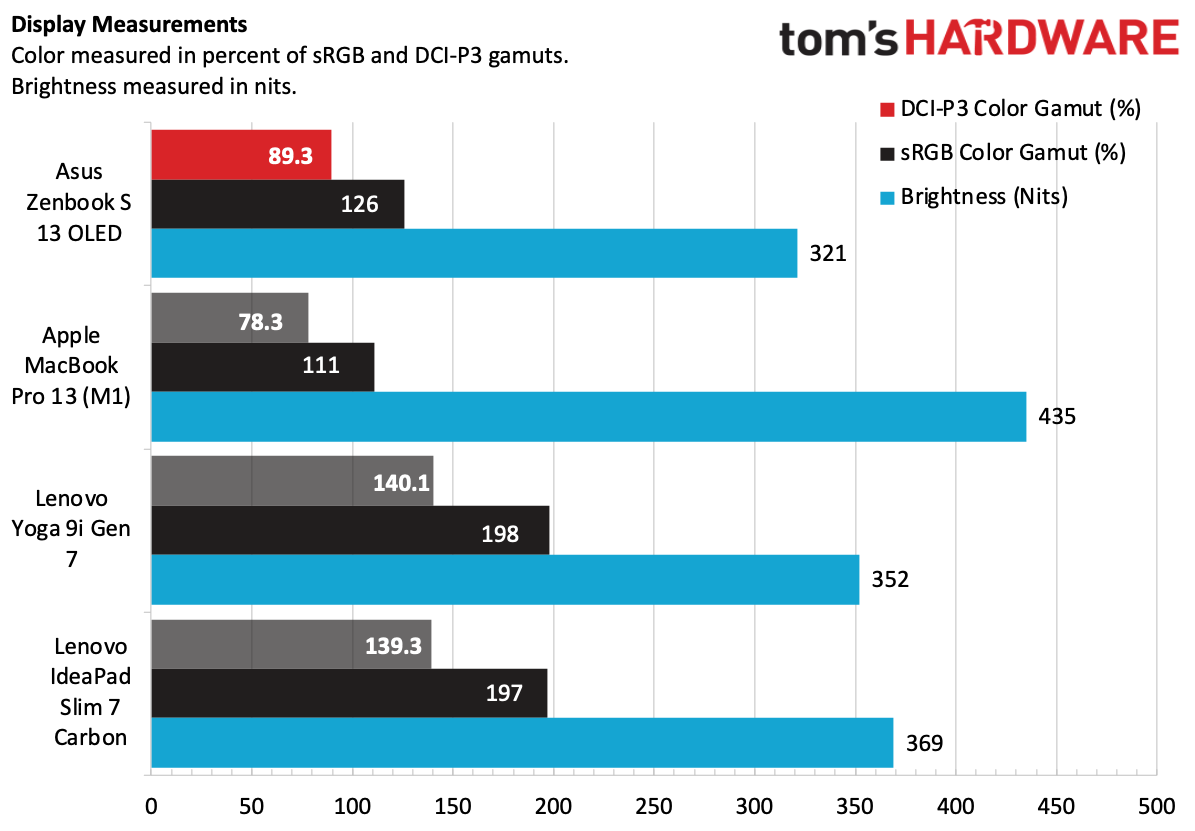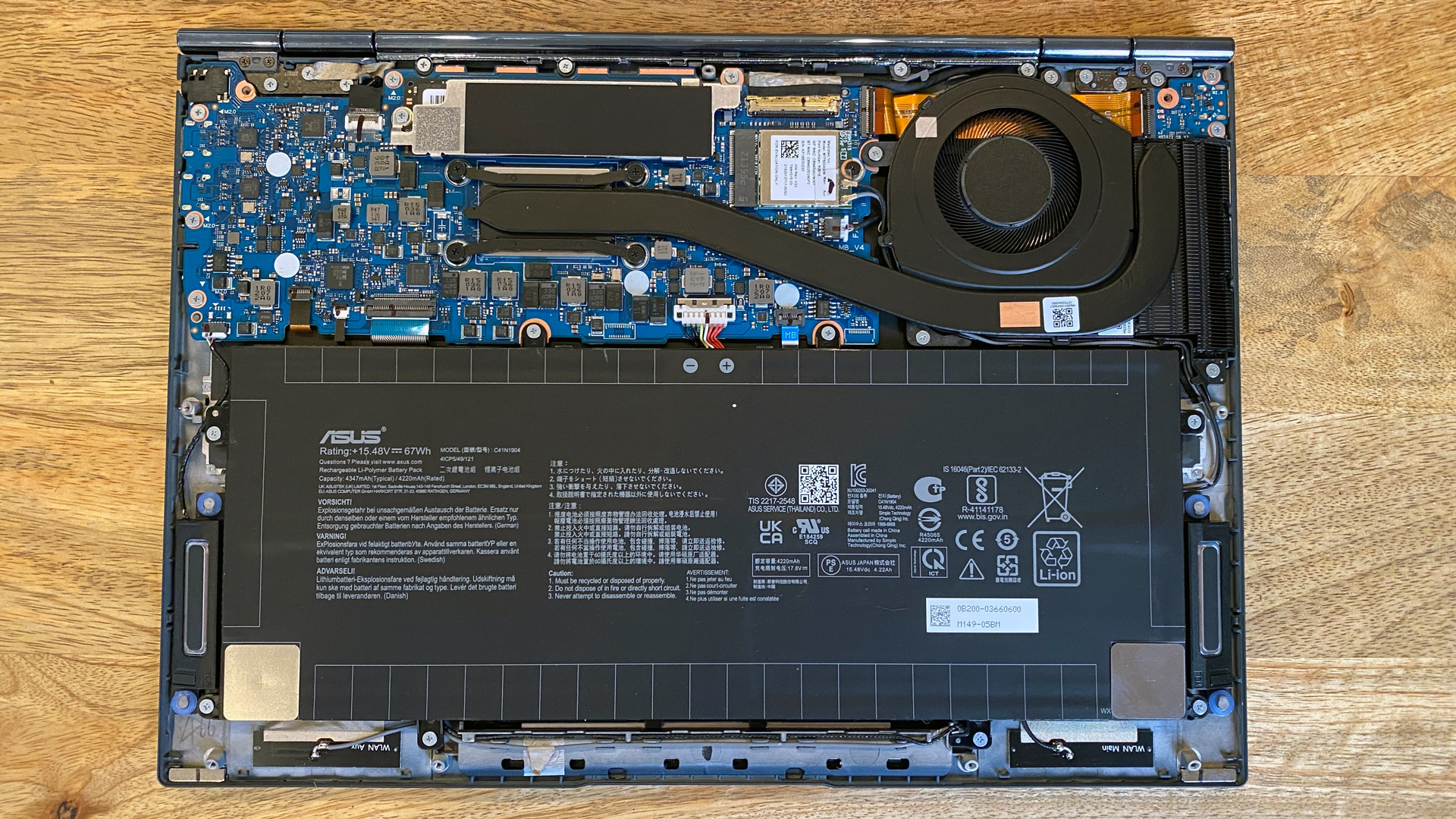Tom's Hardware Verdict
The Asus Zenbook S 13 OLED shows off the power of AMD's latest processors and looks great doing it, but it runs warm and you may need a dongle because it's light on ports.
Pros
- +
Slim, clean design
- +
Long battery life
- +
Strong productivity performance
Cons
- -
Runs warm
- -
Short on ports
Why you can trust Tom's Hardware
If processors tick and tock towards faster performance and increased efficiency, laptops follow a similar pattern, getting smaller and thinner (It's definitely been true on our list of the best ultrabooks). So it's not a huge surprise that the Asus Zenbook S 13 OLED (expected to start at $1,099, tested at $1,499) is a trim, attractive notebook, and among the first to carry the latest from AMD: the Ryzen 7 6800U.
The new Ryzen chip proves potent, and the Asus laptop is more than thin: it also has a high-resolution OLED display and surprisingly long battery life, which is a rare combination.
But that's not to say there aren't any sacrifices. When you get to a certain size, you can only fit so many ports. And hey, the heat has to dissipate somewhere…
Design of the Asus Zenbook S 13 OLED
The Asus Zenbook S13 really is a lovely little laptop. It's not pure aluminum, like some premium designs, but rather a lighter, more plasticky-feeling magnesium aluminum alloy. Still, it looks fashionable. We reviewed the Zenbook in its "ponder blue" colorway, which in some cases is dark enough to look gray.
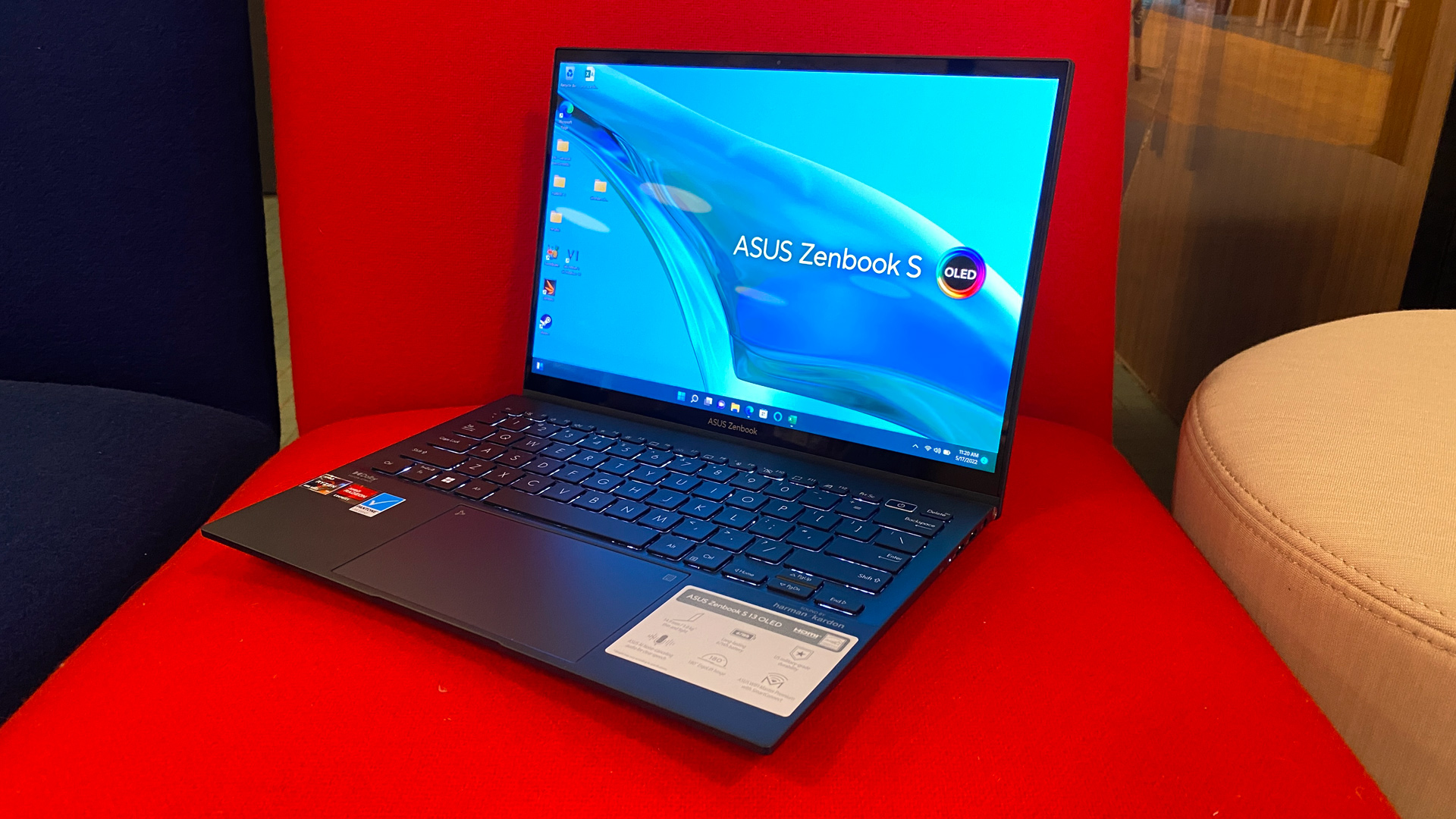

The lid is sparse, with Asus' new, Star Trek-looking A logo right aligned and a small "Asus Zenbook" wordmark.
Let us stop, for a second, to talk about the hinge. Reader, it is a beautiful hinge. Of all of the blue-gray parts of this laptop, it is the most blue. It's attached to a long, circular bar alongside the back of the gadget, creating a piece that looks and feels mechanical on an otherwise ordinary object.
The display is slightly longer than that hinge, lifting the keyboard slightly to what Asus claims is a more ergonomic angle when the notebook is open.
On the keyboard, you may notice that the power button has a silver ring around it. That signifies that it's also a fingerprint reader (it worked fine throughout my testing).
The 16:10 display has thin bezels on its sides with slightly bigger ones on the top and bottom. The deck is the same dark blue cover as the lid, and the keys have white backlighting.
Get Tom's Hardware's best news and in-depth reviews, straight to your inbox.

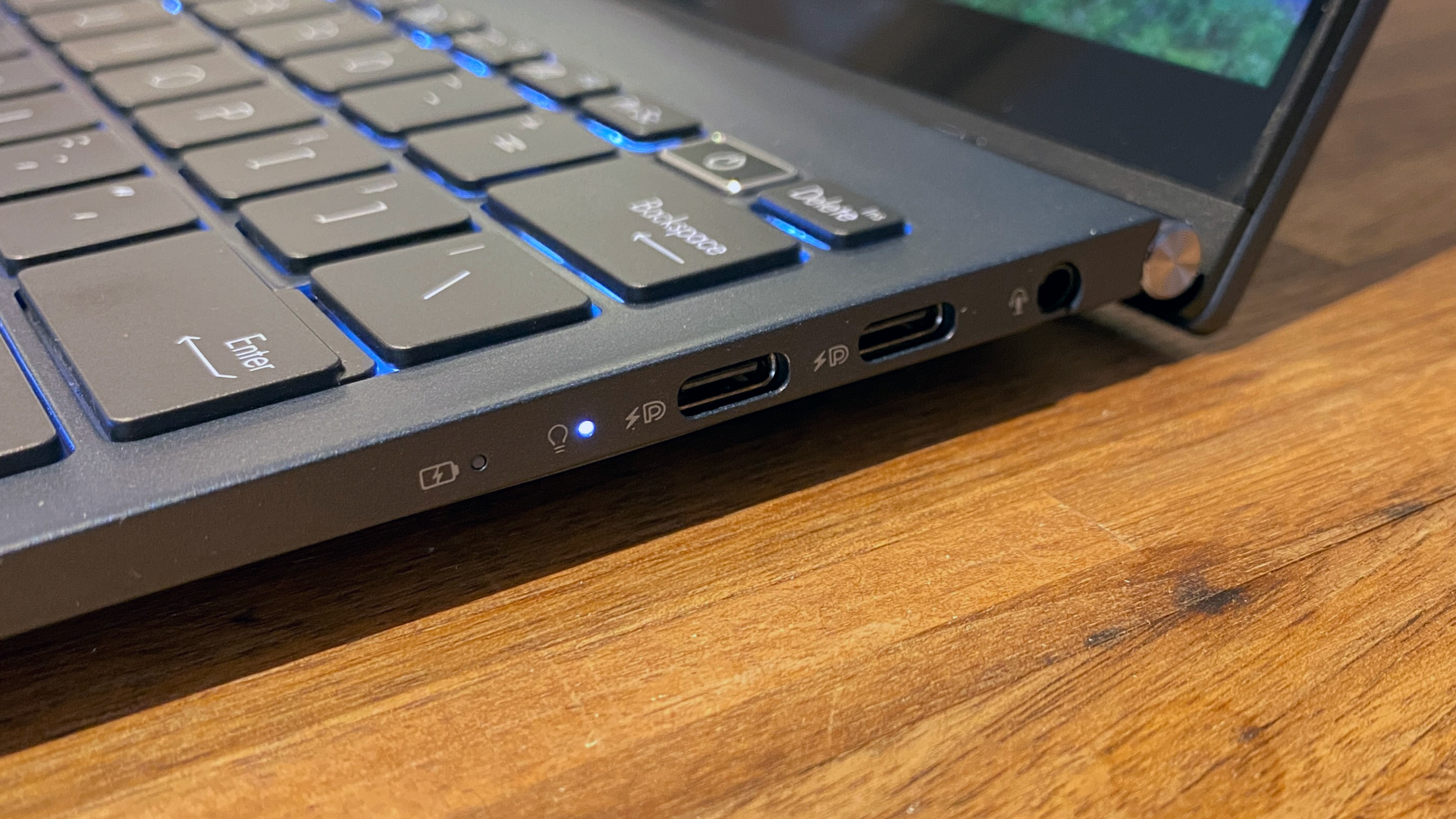
This thin notebook is light on ports. There are three USB Type-C ports (two on the left, one on the right) and a 3.5 mm headphone jack (on the right). That's it. Asus does include a USB-C to USB-A adapter in the box, but those who need HDMI or an SD card reader will need to go buy some dongles.
Of course, a lack of ports is getting to be common on thin notebooks, and the Zenbook S 13 OLED is thin indeed. It measures 11.68 x 8.29 x 0.59 inches and weighs 2.43 pounds. That's smaller than the 13-inch MacBook Pro (11.97 x 8.36 x 0.61 inches, 3 pounds). The Lenovo Yoga 9i Gen 7, an ultra-slim convertible featuring Intel's latest CPU, is 12.52 x 9.06 x 0.6 inches and 3.09 pounds, though it also has a bigger 14-inch screen. Last year's Lenovo IdeaPad Slim 7 Carbon, which had a Ryzen 5000 CPU, was 12.4 x 8.5 x 0.59 inches and 2.4 pounds.
Asus Zenbook S 13 OLED Specifications
| CPU | AMD Ryzen 7 6800U |
| Graphics | AMD Radeon 680M (integrated) |
| Memory | 16GB LPDDR5-6400 |
| Storage | 1TB M.2 PCIe 4 NVMe SSD |
| Display | 13.3-inch, 2880 x 1800, OLED, 16:10 |
| Networking | MediaTek Wi-Fi 6E MTT7922, Bluetooth 5.2 |
| Ports | 3x USB 4 Type-C, 3.5 mm headphone jack |
| Camera | 720p |
| Battery | 67 WHr |
| Power Adapter | 65 W |
| Operating System | Windows 11 Home |
| Dimensions (WxDxH) | 11.68 x 8.29 x 0.59 inches (296.7 x 210.5 x 14.9 mm) |
| Weight | 2.43 pounds / 1.1 kg |
| Price (as configured) | $1,499, per AMD |
Productivity Performance on the Asus Zenbook S 13 OLED
The Zenbook S 13 OLED marks the first time we've seen a Ryzen 6000 series processor. Our review unit came with an AMD Ryzen 7 6800U, an 8-core / 16-thread processor with a base clock of 2.7 GHz and a max boost clock of up to 4.7 GHz.
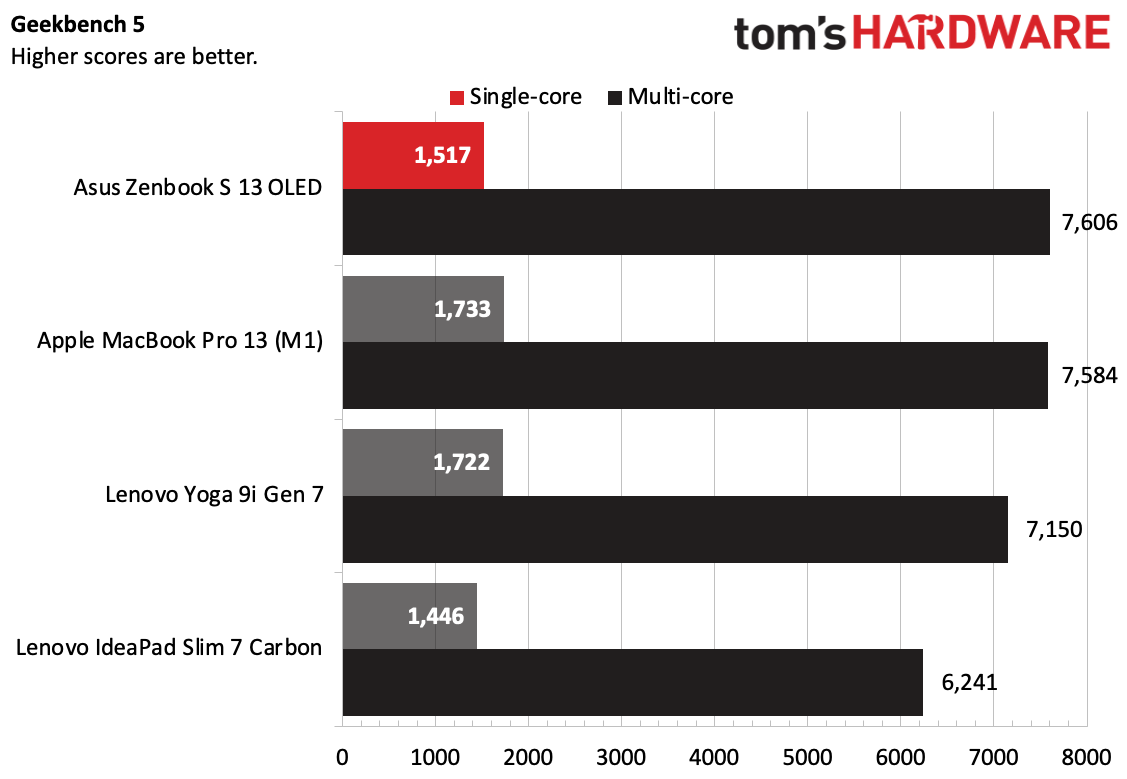

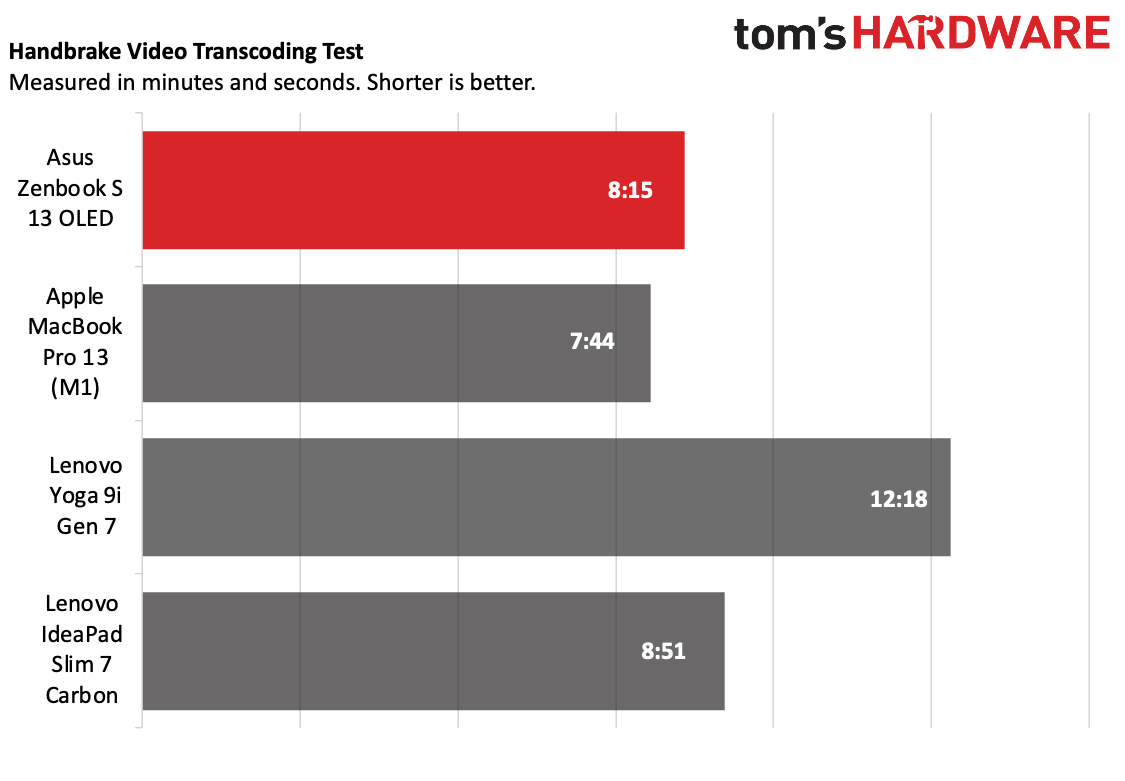
On Geekbench 5, the Zenbook achieved a single-core score of 1,517 and a multi-core score of 7,606. That's neck and neck with the M1 in the 13-inch MacBook Pro, which has a slightly higher single-core score (1,733) and a slightly lower multi-core score (7,584). The Lenovo Yoga 9i Gen 7, with an Intel Core i7-1260P, was ahead on single-core (1,722) but lower on multi-core (7,150).
For comparison's sake, the Lenovo IdeaPad Slim 7 Carbon has a last-gen Ryzen 7 5800U, which unsurprisingly put up worse numbers.
On the file transfer test, the Zenbook proved to be blazing fast. It transferred 25GB of test files at a rate of 1,543.86 MBps, just beating the Yoga 9i Gen 7 (1,506 MBps) and speeding past both the MacBook Pro and IdeaPad.
It took eight minutes and 15 seconds for the Zenbook S 13 OLED to transcode a 4K video to 1080p. That's faster than last-gen, for sure, and also beats the Intel-based Yoga 9i (12:18). Only the MacBook Pro was faster at 7:44.
We stress test ultrabooks by running Cinebench R23 in a cycle twenty times. In this case, the Ryzen 7 6800U started with an impressive score of 10,232. 76, quickly dropped to the low 9,700's, and slowly drifted through the runs down to the low 9,300's. A reduction in score from the first run isn't a surprise, but it sounds like this chip could use some beefier cooling to keep it running at its strongest.
During the stress test, the CPU ran at an average of 2.8 GHz across its 8 cores, with an average temperature 88 degrees Celsius 190.4 degrees Fahrenheit. That's just a bit over base clock when under load for about half an hour.
Gaming on the Asus Zenbook S 13 OLED
We don't have a lot of comparable test results for gaming performance right now, but we did want to test how well the Ryzen 7 6800U could run games. We targeted 1080p at medium settings and tested Borderlands 3, Red Dead Redemption 2, and Shadow of the Tomb Raider. We've collected the results in a table for reference.
| Game | Average | Minimum |
|---|---|---|
| Borderlands 3 | 31.7 | 21.7 |
| Red Dead Redemption 2 | 27.6 | 22.4 |
| Shadow of the Tomb Raider | 28.0 | 23.0 |
1920x1080 and medium quality was still asking just a bit too much of the integrated Radeon 680M, but adjusting the resolution to 1600x900 should get most games into the 30 fps or higher range. These are also relatively demanding games, so lighter fare shouldn't be a problem.
We did run some comparison tests against a few other laptops we had handy, with Intel Iris Xe (96 EUs) and a GeForce MX330. The 680M was about 80% faster on average, though do note the more recent MX450 and MX550 are quite a bit more potent. At the same time, the Ryzen 7 6800U was able to do this within a 15W power envelope, and it's certainly more capable than the special Van Gogh processor in the Steam Deck — it has twice as many CPU cores, running the newer Zen 3+ architecture, paired with 12 RDNA 2 compute units (50% more than the Steam Deck).
We'll be doing more graphics performance comparisons of competing solutions going forward, using these same settings. Ideally, we'd like to see games keeping minimums above 30 fps at 1080p, but this isn't actually a gaming laptop as such. It just happens to work moderately well as a lightweight gaming solution if you keep your expectations in check.
Display on the Asus Zenbook S 13 OLED
If you like deep blacks and pops of color, the Zenbook S 13 OLED's 2880 x 1800 touchscreen delivers. I had no complaints when I used it; that's for sure. But it's not as bright or vivid as some other panels with the same technology that we measured with our colorimeter and lightmeter.
I used the 13.3-inch screen to watch Tears of Steel, our 4K test video. Sure, this screen isn't 4K, but I also needed something better than the 1080p video I watched on it in my spare time to push this thing. That short film has lots of neon colors, including pinks and greens that popped off black walls in a lab.
The Asus Zenbook S 13's OLED screen proved decently vivid at 126% of the sRGB color gamut and 89.3% of the DCI-P3 gamut. That's more vibrant than the LED screen on the 13-inch MacBook Pro, but the OLED panels on Lenovo's Yoga 9i Gen 7 and IdeaPad Slim 7 Carbon won out on both color spectrums.
At 321 nits of brightness, the Zenbook S 13 is absolutely usable. But the MacBook won out again at 435 nits, while the Yoga 9i (352 nits) and Ideapad Slim 7 Carbon (369 nits) were also both a bit brighter.
Asus has gone with a 16:10 aspect ratio here, which is nice because it provides more vertical real estate than a standard 16:9 screen. I think Asus could do one better and go 3:2 for even more vertical space here, like Microsoft's Surface lineup, though that's a personal preference of mine.
Battery Life on the Asus Zenbook S 13 OLED
Ryzen continues to show how efficient an x86 platform can be on battery life. The Zenbook S 13 OLED lasted for 11 hours and 2 minutes on our battery test, which browses the web, streams video and runs graphics tests, all with the display set to 150 nits and while connected to Wi-Fi.
Still, Arm proved even longer-lasting. The 13-inch MacBook Pro with Apple's M1 chip ran for 16:32. But the Zenbook proved to be a big improvement over the Yoga 9i with Intel's 12th Gen P-series and a nice update from the IdeaPad, with a previous-gen AMD chip, at just under 10 hours.
Keyboard and Touchpad on the Asus Zenbook S 13 OLED
If you like your keyboards with a bit of click and clack, you'll enjoy typing on the Zenbook. The keys, with 1.4 millimeters of travel, make an audible tactile sound that people around you will hear. There's the slightest hint of a tactile bump while pressing down.
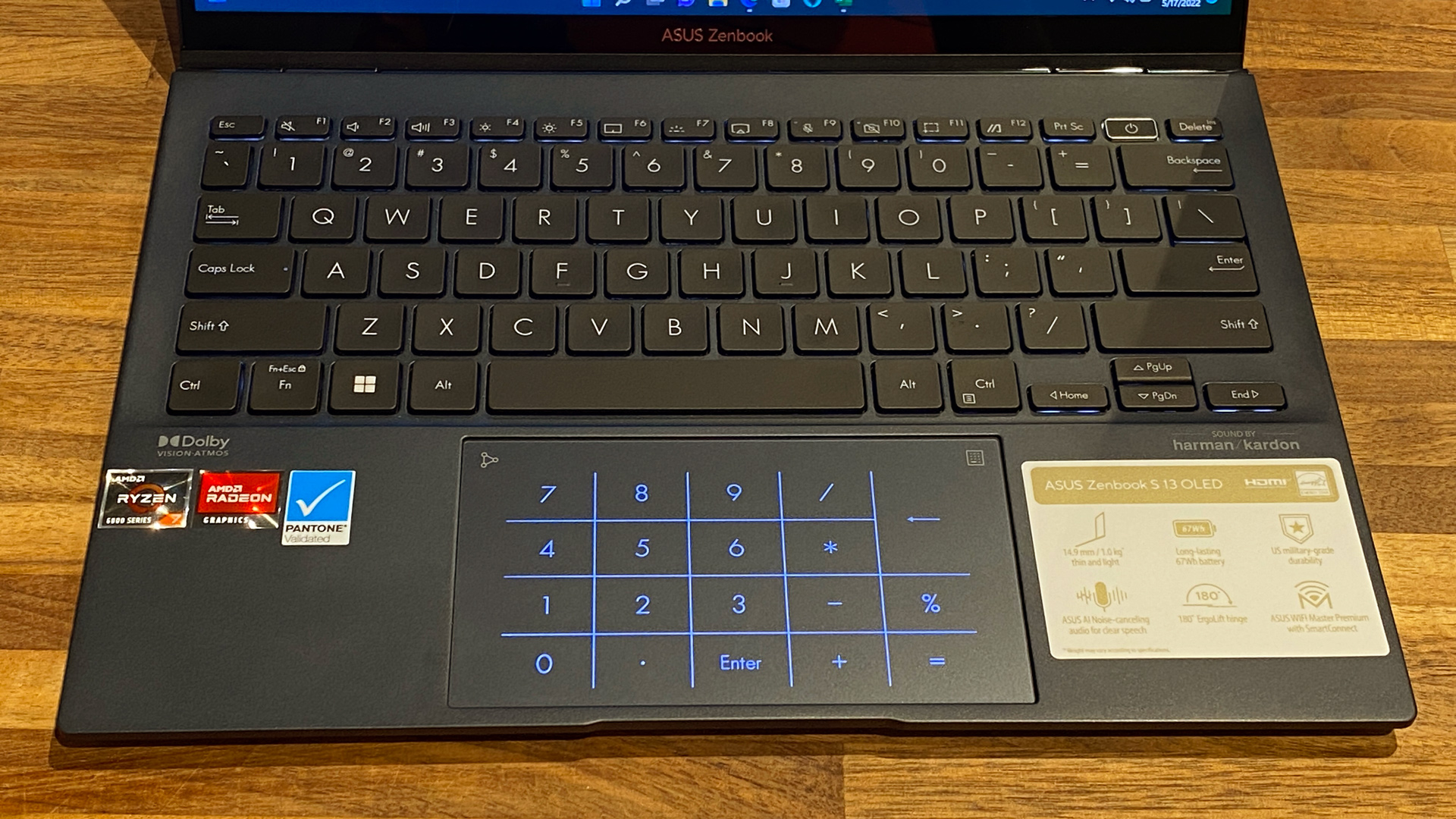
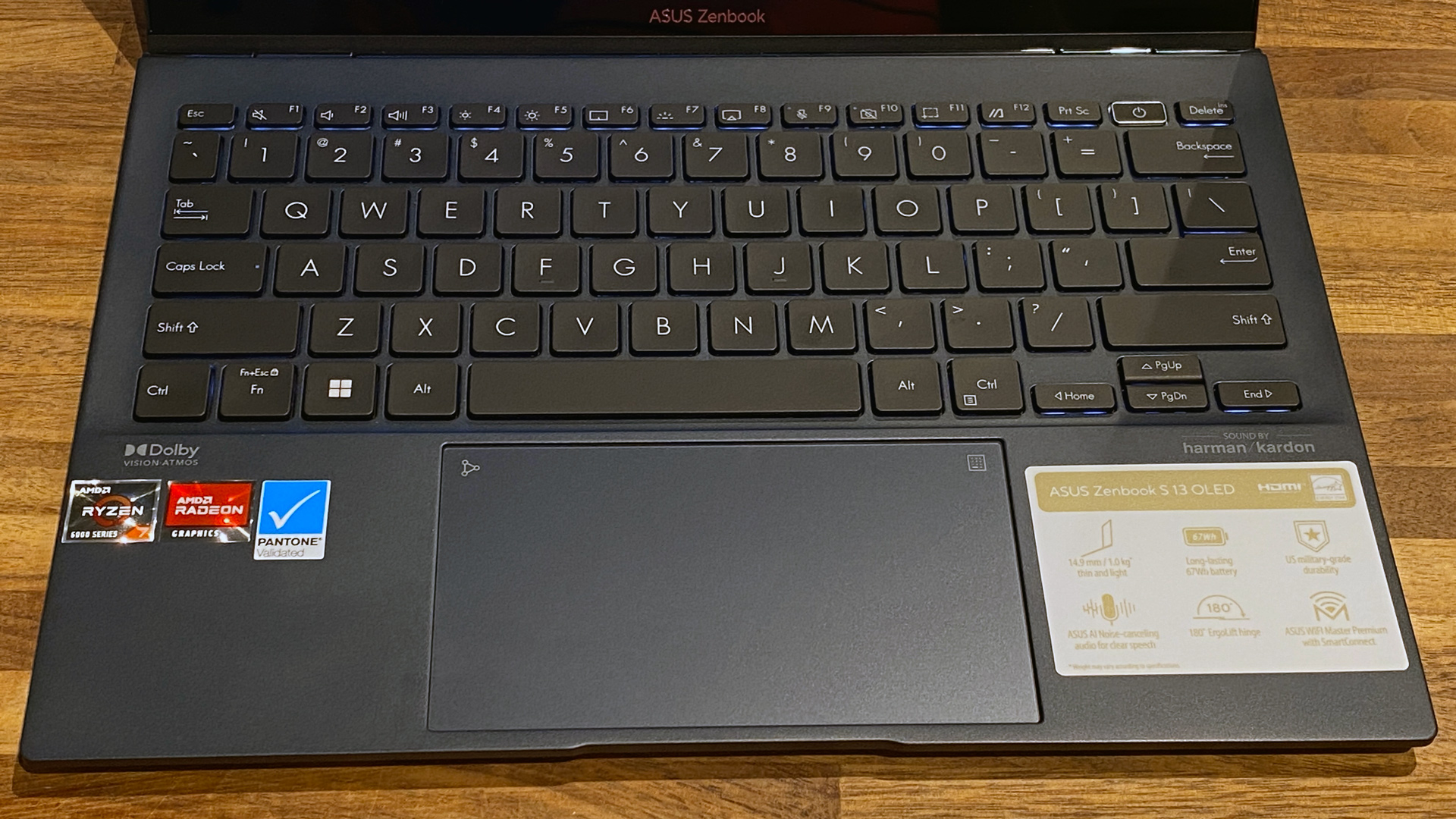
When I used the laptop, I felt that the laptop was a bit warm to the touch. That’s not in a way that would burn my fingers or even stop me from using it, but more noticeable than on some other laptops I've used.
The touchpad is nice and spacious, which I appreciate. There's plenty of room whether you're just navigating a web browser or performing Windows 11's most complicated three or four-finger gestures. It's got a bit of drag when you scroll, but nothing I couldn't get used to.
This Zenbook, like many others, also has Asus' "NumberPad" feature built in the trackpad. With a tap in the corner of the surface, you can turn on a touch-based numberpad, or, in the opposite corner, also launch the calculator. I get that some people may want a dedicated number pad for productivity, especially if they work in a lot of spreadsheets, but after years of this feature I'm still convinced this isn't the best implementation. It's clunky and makes me look away from the screen.
Audio on the Asus Zenbook S 13 OLED
While Asus has tuned the stereo sound system in a way that accomplishes incredible volume, it's not as even as I like my music to be.
I listened to MUNA's "Everything But Me" in a conference room, which was filled with sound from the two speakers. But the Zenbook prioritized the vocals at the expense of everything else, and I found that the guitars, keyboards and drums kind of melded together.
This focus on voice is good for calls, but less for jamming out to music on Spotify while you work. If you prefer some control, the Dolby Access app lets you change the EQ. I found that the "detailed" equalizer setting gave me a bit more of the snappy drums and melodic keyboards I like from my music.
Upgradeability on the Asus Zenbook S 13 OLED
The good news is that, yes, technically, the Zenbook S 13 OLED is user upgradeable, with some repairable parts. The bad news is that I get the sense that Asus really doesn't want you to open this thing.
There are seven tiny Torx screws on the underside of the Zenbook S13 OLED. Fine, not everyone has a Torx driver, but it ends up it's a bit of a fakeout. There are two more screws underneath the laptop's back feet. I was able to peel these back carefully, but it's a risk. When laptop manufacturers put screws under adhesive feet, owners risk tearing them when trying to remove them. Also, adhesive feet are never as good after they've been reapplied. I would recommend people don't peel them off unless they have no choice, or to at least consider a professional repair service if they don't have much experience in repair.
Asus has seven visible screws on the chassis already; I don't know why this company is so dedicated to putting extra screws where people can't easily reach them.
Once the screws are all out, I made quick work of the bottom casing with a pry tool. Most of the inside consists of a battery and a small motherboard. The RAM is soldered down, but the SSD and networking card are both replaceable.
Heat on the Asus Zenbook S 13 OLED
To get an idea just how hot the Zenbook S 13 OLED runs, we took skin temperatures during our stress test, running Cinebench R23.
During that gauntlet, the center of the keyboard measured 39 degrees Celsius (102.2 degrees Fahrenheit). This is a little toasty, and I could feel heat on the keycaps even in normal use. It was never too uncomfortable to use, however. Meanwhile, the touchpad measured 32.8 degrees Celsius (91 degrees Fahrenheit), which is warm for a touchpad, but not particularly noticeable to me in regular use.
The hottest point on the bottom of the laptop measured 49.5 degrees Celsius (121.1 degrees Fahrenheit, though most of the surface was closer to what you got on the keyboard.
Webcam on the Asus Zenbook S 13 OLED
Asus is using a 720p webcam on the Zenbook S 13 OLED. While higher resolution doesn't necessarily mean better image quality, I'd still like to see a move to 1080p.
The webcam on the Zenbook S 13 skews warm. In a well-lit room, my red shirt, which is already quite bright, came off orange, while my skin tone also had a very slight Oompa Loompa tinge that was better when I wasn't next to a window. Is it usable? Sure. Is it great? No.
Software and Warranty on the Asus Zenbook S 13 OLED
While Asus isn't too heavy-handed with its software, its preloads doesn't strike me as particularly useful. MyAsus is perhaps the best of them, with links to warranty information, product registration and a handful of options. But some of those changes can be made elsewhere in Windows. The app also has a promotions tab for partner deals, which is the kind of advertising that doesn't befit a premium notebook.
An app called GlideX lets you use a tablet as a second screen. Notably (perhaps scarily, to some), it asks if you want to use its "comprehensive" China service or its global version. You need to install an app on an Apple or Android device to get it to work. I was able to get it to run on my iPhone, though I can't say I'd recommend it, as it's so small. Some parts of the software require a monthly subscription, like high quality, ad-free streaming.
ScreenXpert is designed to let you manage which apps run on which displays, but I'm of the opinion that Windows 11 handles that pretty well on its own now. (This wasn't the case in Windows 10). It also adds quick toggles to the side of your screen to turn your microphone and camera on or off.
Like many Windows laptops, the Zenbook S 13 ships with trial antivirus. In this case, it's McAfee Live Safe. Asus has also added a link to McAfee's website in the Edge browser, along with links to its own software. Amazon Alexa is also on board, though you need to sign in with an Amazon account to use it.
For everything AMD, there's Radeon Software, which shows component usageand activate Radeon-specific features like Chill (to reduce FPS in order to save on power) or Anti-Lag (to tamper input lag).
Our review unit didn't have much of the bloat that comes with Windows 11, but I wouldn't be surprised if final shipping units in Q3 of this year have some music, social media apps or games from the Microsoft Store.
Asus Zenbook S 13 OLED Configurations
We tested the Zenbook S 13 OLED with a Ryzen 7 6800U, 16GB of RAM and 1TB of storage. Asus tells me that the laptop will be available on Amazon in Q3, with a price coming closer to launch. AMD, however suggested that the suggested retail price for this unit would be $1,499.
AMD also told us that a model that's nearly identical except for a smaller 512GB SSD should start at $1,299. The base model, with a Ryzen 5-6600U and 8GB of RAM, 512GB of storage and a non-touch display is expected to be $1,099.
Bottom Line
The Asus Zenbook S 13 OLED is an ultralight, ultrathin notebook that happens to play home to AMD's latest processors. It's a laptop that's sleek and attractive, but also powerful — as long as you're willing to put up with some heat.
If you want something with a wider variety of ports while still being sleek and slim, the Lenovo Yoga 9i, a 14-inch Intel-based 2-in-1, may be up your alley. But in our testing, it was slightly behind in performance and more expensive when similarly configured. It did, however, have a slightly higher quality OLED display.
So if portable power (at least, as much as you can cool with a single fan) is on your list, the Zenbook S is a solid option, as long as you can put up with dongles and a little excess warmth.

Andrew E. Freedman is a senior editor at Tom's Hardware focusing on laptops, desktops and gaming. He also keeps up with the latest news. A lover of all things gaming and tech, his previous work has shown up in Tom's Guide, Laptop Mag, Kotaku, PCMag and Complex, among others. Follow him on Threads @FreedmanAE and BlueSky @andrewfreedman.net. You can send him tips on Signal: andrewfreedman.01
-
-Fran- Too bad you didn't do gaming, but it reads like a very decent competitor in the segment.Reply
My GF is in the market for these laptops, so she'll love to have an AMD option as she hates the HP Envy with the nVidia graphics, haha.
Regards. -
abufrejoval Reply-Fran- said:Too bad you didn't do gaming, but it reads like a very decent competitor in the segment.
My GF is in the market for these laptops, so she'll love to have an AMD option as she hates the HP Envy with the nVidia graphics, haha.
Regards.
The iGPU is the main differentiator of the 6800U vs the 5800U, so to leave it out is missing the USP: very disappointing!
I understand that you want to publish fast and that a proper GPU evaluation may be more involved, so I can only hope that will come very soon.
It's especially interesting because it will offer some hints on what will be possible in terms of graphics with the next generation APUs based on Zen4 but a similar iGPU design.
For me RAM upgradability is a major concern, because the ability to run various VMs is critical so I like spending a reasonable extra for 64GB. Unforunately notebook vendors are rarely reasonable when it comes to the price for extra RAM and of course it doesn't help that the form factor and LPDDR5 favor soldered RAM chips and nobody wants to stock high-capacity SKUs.
So I wonder if at least this time around a 32GB SKU is available? -
JarredWaltonGPU Reply
Andrew was a bit under the gun to get the review up, but we've added some graphics tests after the fact. Unfortunately, we don't have comparable performance data from other laptops we've reviewed, as that hasn't been something deemed "important" on non-gaming laptops. We're planning to test the graphics performance of some of the other budget "non-gaming" laptops going forward, to build out our suite of results. Right now, it looks like the Radeon 680M is about 80% faster than Intel's Iris Xe 96 EU graphics solution, which is used in both Alder Lake and the older Tiger Lake. It's also a big step down from the sort of performance you'd get from even a GTX 1650 laptop solution.-Fran- said:Too bad you didn't do gaming, but it reads like a very decent competitor in the segment.
My GF is in the market for these laptops, so she'll love to have an AMD option as she hates the HP Envy with the nVidia graphics, haha.
Regards. -
deesider Reply
For a relatively high resolution screen like 2880 x 1800 would you consider doing a half-resolution test (1440 X 900), since I assume it would be less blurry than a re-scaled 1600 X 900? Or does it make little difference?JarredWaltonGPU said:Andrew was a bit under the gun to get the review up, but we've added some graphics tests after the fact. Unfortunately, we don't have comparable performance data from other laptops we've reviewed, as that hasn't been something deemed "important" on non-gaming laptops. We're planning to test the graphics performance of some of the other budget "non-gaming" laptops going forward, to build out our suite of results. Right now, it looks like the Radeon 680M is about 80% faster than Intel's Iris Xe 96 EU graphics solution, which is used in both Alder Lake and the older Tiger Lake. It's also a big step down from the sort of performance you'd get from even a GTX 1650 laptop solution. -
abufrejoval Well APUs aren't just about gaming, a message that AMD has been trying to push out for a long time, even if HSA remains a sad and unfullfilled promise still.Reply
And not even 3D is all about gaming, advanced visualization profits from it as well.
Personally I just love looking at Google Maps in the "earth mode" with Globe View enabled and satellite data being rendered into 3D by some nifty AIs.
Unfortunately my favorite browser, Firefox there does much worse than Chromium based ones like Brave but instant response to shifts, zooms and rotations on a 4K screen are possible with these beefier iGPUs. BTW it does much better then the orignal standalone Google Earth application, which evidently never got the really smart code. And it fully puts µsoft's FlightSimulator to shame, both in terms of map quality and 3D performance... but that's another story.
Intel has long suffered from the same attitude as you, thinking that iGPUs don't need or systematically can't really offer great 3D performance, because the required RAM bandwidth simply isn't there.
And AMD then has jumped the gun on Intel two times, a) by offering APUs that did offer much better iGPU performance at similr prices (e.g. Kaveri) and b) by allocating iGPU silicon real-estate to CPU cores instead, doubling core vs. Intel at the same process size and price point (Zen 1/2/3).
It was only on behest of Apple demanding better iGPU performance that Intel started their Iris Plus/Pro souped up 48/96 vs. the normal 24EU iGPUs which put 64/128MB of EDRAM on the die carrier to achieve the bandwidth required to make use of the extra GPU cores.
I have hardware from all these generations. E.g. a Kaveri A10-7850K with 512 SMs that required optimal DDR3-2400 DIMMs to benefit and did only marginally better than the 384 SM variant because it was starved for bandwidth.
It was pretty awsome to see how that at 90 Watts almost exactly matched the performance of my Iris Plus equipped Skylake i5-6267U dual-core with HT 48EUs, 64MB EDRAM and DDR3-1333 RAM at 28 Watts both in CPU and GPU workloads.
My Tiger Lake NUC with 96EUs and my Ryzen 5800U based notebook both manage to do without EDRAM and only get slightly better RAM bandwidth but evidently manage to get a lot more GPU power out of the extra SMs.
I don't know if its vastly bigger caches or software drivers that know how to use them in such a way that only the final render has to suffer from the relatively low bandwidth of their DDR4/5 frame buffers. Where 48EUs on a Gen8 NUC with the bigger Iris Plus only offered 50% uplift of performance vs. the 24EU NC Gen10 iGPU, the 96EU iGPU on the Gen11 NUC reached 4x the performance of the 24EU variant or linear uplift.
On GPU workloads or games Tiger Lake was around 20% faster than the 5800U, so the iGPU update on the 6800U should definitely help to bring overall leadership in the 15-28 Watt class of laptops without a dGPU.
And for the 7000 series APUs AMD is repeating the promise it used to make for Kaveri: a reasonable gaming experience, only this time at 1920x1080 when it was 1280x720 on Kaveri.
At 4k even my RTX 2080ti in combination with a Ryzen 9 5950x is hopelessly overtaxed most of the time, but it's really there only to run CUDA not games. -
JarredWaltonGPU Reply
The problem with tailoring testing to a specific laptop screen is that it would make it more difficult to compare results. This particular laptop should probably run games at 1440x900, as you suggest, but many laptops have 1080p displays and so that makes more sense as an apples-to-apples testing target. I'd say that if you drop the number of pixels rendered in games by 37.5%, you should expect performance to improve by 15–20%. We could try to test that, but it's more time spent and thus less likely to get done.deesider said:For a relatively high resolution screen like 2880 x 1800 would you consider doing a half-resolution test (1440 X 900), since I assume it would be less blurry than a re-scaled 1600 X 900? Or does it make little difference? -
-Fran- Reply
I would say that maybe testing RSR (via mods or driver) and FSR in it would make sense then?JarredWaltonGPU said:The problem with tailoring testing to a specific laptop screen is that it would make it more difficult to compare results. This particular laptop should probably run games at 1440x900, as you suggest, but many laptops have 1080p displays and so that makes more sense as an apples-to-apples testing target. I'd say that if you drop the number of pixels rendered in games by 37.5%, you should expect performance to improve by 15–20%. We could try to test that, but it's more time spent and thus less likely to get done.
You can still standardize the testing at a fixed resolution, I guess. Or just make it a Pixel count per frame time to normalize the results. It should be somewhat fair? Like: this laptop takes x-ms to deliver y-MP on screen and that becomes a normalized measure you can use to compare. Not perfect, but it does give perspective in conjunction with the standardized test. You could give the normalization theory a go with regular setups and validate variances so they're taken into account. Hey this doesn't sound too dumb now that I think about it, heh.
Regards. -
akithtsuki USB4 ?Reply
"
Ports3x USB 4 Type-C, 3.5 mm headphone jack"
I saw onlt USB3.2 gen 2 from asus website
"
I/O Ports
3x USB 3.2 Gen 2 Type-C support display / power delivery
1x 3.5mm Combo Audio Jack
"
https://www.asus.com/Laptops/For-Home/Zenbook/Zenbook-S-13-OLED-UM5302-AMD-Ryzen-6000-series/techspec/ -
watzupken Reply
It is not as fast as a GTX 1650, that is to be expected. After all, this is supposed to be an APU that sustains a 15 to 28W TDP. It is really to see how much of a difference people can expect in 3D applications by moving from the aged Vega to RDNA2. The mobile GTX 1650 will require something like a H series processor to catch up due to higher power limit and also better cooling solution deployed.JarredWaltonGPU said:Andrew was a bit under the gun to get the review up, but we've added some graphics tests after the fact. Unfortunately, we don't have comparable performance data from other laptops we've reviewed, as that hasn't been something deemed "important" on non-gaming laptops. We're planning to test the graphics performance of some of the other budget "non-gaming" laptops going forward, to build out our suite of results. Right now, it looks like the Radeon 680M is about 80% faster than Intel's Iris Xe 96 EU graphics solution, which is used in both Alder Lake and the older Tiger Lake. It's also a big step down from the sort of performance you'd get from even a GTX 1650 laptop solution.
As for gaming resolution, there is no miracle here. The TDP simply won’t allow the iGPU and CPU to run at high clockspeed under sustained load. In fact, it is more likely the APU run into thermal limit given the slim laptops these U series processors are used. So the best case scenario is going to be 1080p at low graphic settings. I may be wrong, but even though the aspect ratio of the monitor is not 16:9, you can still apply a 1080p resolution. At most you just get black bars above and below. But that helps standardise testing for ease of comparison.


